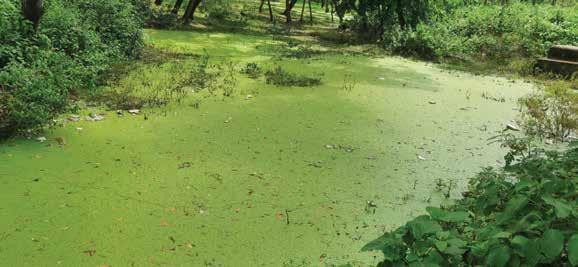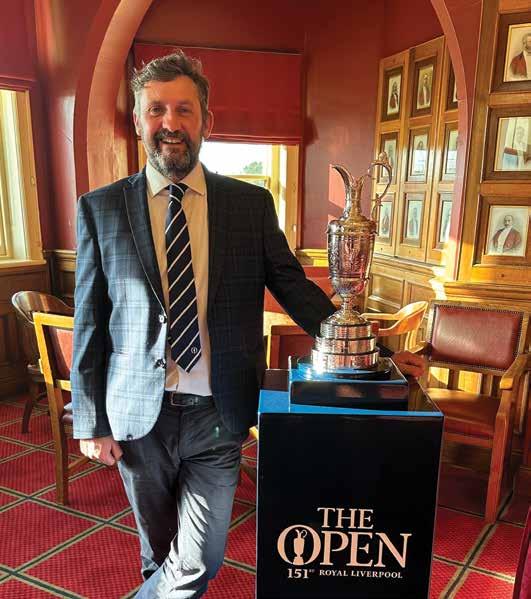
6 minute read
BASIS FACTS
- its relevance to anyone with responsibility for nutritional inputs
WHO IS THE COURSE FOR?
This course is designed for those who wish to pass the FACTS examination leading to the Certificate of Competence in Fertiliser Advice. It will also be of interest to those who have qualified for the BASIS Professional Register and want to gain Continuing Professional Development points.
The course assumes a basic prior level of agronomic knowledge which then builds on principles and practice of fertiliser recommendations and nutrient planning.
It is essential that delegates are familiar with a range of nutrient issues, and have sufficient supervised field experience before attempting the exam.
Our Troubled Rivers aired in March. It turned the spotlight on nitrate and phosphate leaching into our waters and this issue is mainstream in the public eye and firmly in the focus of legislators.
The comparative scale of inputs by amenity vs agriculture are small, but there is no escaping that our sector must, and will be forced to play our part in improving our environmental footprint when it comes to nutritional inputs.
So, what can we do as an industry to play our part and get ahead of the curve?
As a recent gradate of the BASIS FACTS course, passionately and charismatically delivered at the STRI by Dr Christian Spring, undoubteldy some of the answers sit with stewardship and education on fertiliser use. Traditionally considered a course for perhaps ‘the more responsible amenity trade manufacturers and distributors’, it was encouraging to see a practising Golf Course Manager and School Grounds and Estates Manager undertake the same qualification.
With 55% of England’s land classified as Nitrate Vulnerable Zone (NVZ), can undertaking a BASIS FACTS really help you and your organisation in procurement, nutritional decision making and safeguarding nutrional inputs in the future?
I asked Daniel Ratling Grounds and Estate Manager at Whitgift School and Andrew Kerr MG of Surbiton Golf Course to share their experience with an ‘end user perspective’.
Daniel Hughes, Head of Commercial, Agrovista Amenity - BASIS
DANIEL RATLING
I undertook the BASIS FACTS training and assessment in 2022. I am responsible for agronomic assessments and writing our nutritional programmes. I wanted to ensure my CPD was up to date and that I was compliant with industry best practice.
The course delivery was excellent. Dr Christian Spring was engaging throughout the three days and the follow up sessions were well delivered. My colleagues on the course were knowledgeable and it was valuable mixing with people from other sections of the industry. The assessment process felt robust, I revised hard and happily passed.
Much of the technical course content I had covered previously throughout my studies, but it was still useful to refresh and bring up to date. We touched on agricultural regulations (NVZ’s) and post-Brexit legislation which was useful. I think the focus on minimising environmental impact is the main theme I took away. This is something we all need to consider and act appropriately now before legislation/ restrictions are imposed.
I would encourage anyone with responsibility for nutritional inputs to undertake this course. It has real relevance across the industry including for practitioners.
ANDREW KERR
Your motivation for doing BASIS FACTS as a Course Manager
� To ensure that I have all the facts and knowledge about fertilisers - including the theory, manufacturing process and the pros and cons of all products available
� To improve my understanding of the limitations of fertilisers and ensure cost effectiveness of applications and prevent budget wastage
� To understand the current environmental impact of fertilisers.

Your experience of the course
The course itself was very well run - despite the pace making my brain ache a little at times! It went through all aspects of fertiliser uses to ensure we had a background of both theory and practical knowledge.
Christian is very knowledgeable, and therefore any questions were answered concisely and were easy to understand. Doing the course as a group was very beneficial to share knowledge and experiences. Coming from different backgrounds allowed us to help each other look at the information from different perspectives which also helped greatly. How do you feel it has benefitted you as an end user and buyer of fertiliser?
I now have a better understanding of fertiliser and how this can affect the environment, especially reaching water courses. Plus an understanding of the impact on different soil types and the science behind the uptake of the nutrients and how they are used.
The soil in relation to plant nutrition
The nature and properties of fertilisers
Organic fertilisers
Crop nutrients and the basis for calculating the amount of fertiliser required
Use of fertilisers on the main crop groups in the UK Transport, storage, handling and labelling requirements necessary to protect the environment
Codes of good practice

Royal Liverpool Golf Club (Hoylake), as most in the world of sports turf management will recognise, is a world-famous golf course steeped in traditions of tournament history.

Royal Liverpool Golf Club is located in the small town of Hoylake, at the northwest corner of the Wirral Peninsula. The golf course extends between Hoylake and the neighbouring town of West Kirby.
It has a single 18-hole course, which is a seaside links. Robert Chambers and George Morris were commissioned to lay out the original 9-hole course, opened in 1869 which was then extended to eighteen holes two years later. This fact makes the club the second oldest golf links in England, pre-dated only by the Royal North Devon Golf Club, in Westward Ho! Devon.
It has hosted numerous major professional tournaments both male and female. Notably, The Open in 2006 with Tiger Woods finishing in first place, the now AIG Women’s Open in 2012 being won by South Korea’s Jiyai Shin and more recently, the last Open hosted at Hoylake being won by Rory McIlroy who lifted the Claret Jug in 2014.

‘Bledge’
For those of us in the sports turf world, who have been fortunate to have met or know James Bledge, we all can testify that ‘Bledge’ is a very personable golf course manager! Now don’t worry, I’m not being rude by calling him by his surname, ‘Bledge’ has always been so-called since childhood (even Mrs Bledge calls him ‘Bledge’)! He is a firm believer in achieving the absolute best results through his people and, to that end, is a great advocate of education, skill development and career progression. Bledge has always been hungry for more tournament golf experience, stemming from his early days preparing for the many Dunhill Cup competitions whilst at Kingsbarns Golf Links, and through all his tournament support volunteering work. One of Bledge’s many respected attributes is his all-encompassing passion for communication, whether that be to his Board, membership, or his team. “Not only do I get a great sense of accomplishment from communicating, but I also thrive on hosting large golf tournaments,” confessed Bledge, “and I prioritise my beliefs in promoting fine grasses and encouraging sustainability, whilst utilising all of the modern technology available within our industry.”
His story starts upon completion of his National Certificate in greenkeeping back in 1996 and landing his first role as Assistant at Dumfries & Galloway Golf Club. During his five years, he also achieved his Higher National certificate (1998) and later in 2004 his Higher National Diploma in golf course management before he received the calling for a one-year stint at Norwegian club Miklagard before returning home to Gullane Golf Club in Scotland for a short term. In 2006, he got the opportunity to join the team at the prestigious Kingsbarns Golf Links in Scotland as Senior Greenkeeper. Whilst there, he got his first taste of tournament life, helping to host three Dunhill Cups. In 2009, Scandinavia called again, this time a grow-in experience at the PGA Swedish National in the PGA resort in Bara around 6 miles east of Malmo.



A year later, with grow-in completed, a return to Scotland and gWest International Resort, as Senior Greenkeeper for yet another grow-in of their heathland/fescue dominant course; a position he held for three years before his move ‘down south’ to Royal Cinque Ports Golf Club, Kent. Initially, it was as Course Manager, before being promoted to Golf Course and Estates Manager soon after. His role developed into full management of the entire golf course and estate, responsible for a team of twelve, including both course and estates budgets and responsibility for short and long-term planning at the club. This is where we now pick up the story with Bledge, as he embarks as Links Manager at Royal Liverpool Golf Club, and as he prepares for one of his greatest challenges (and in any turf manager’s career), preparing for one of the largest sporting events in the world - The Open.
It’s all in the planning
Like most successful managers, Bledge is obsessive about detail and planning! As any good turf manager will testify, good planning
The New 17th
The newly constructed 17th par three hole, has been designed by Martin Ebert of Mackenzie and Ebert fame, built by Golf Link Evolve in 2020. The 330-metre square postage stamp size green is surrounded by revetted bunkers and a host of sand scrapes whilst perched atop a sand dune!
To the rear of this spectacular green flows the river Dee estuary, and Bledge points out that he and his team get great satisfaction from working with The Cheshire Wildlife Trust to help support and maintain the two kilometres of estuary banks which form the club’s boundary.










